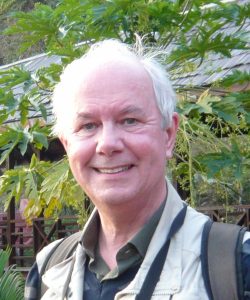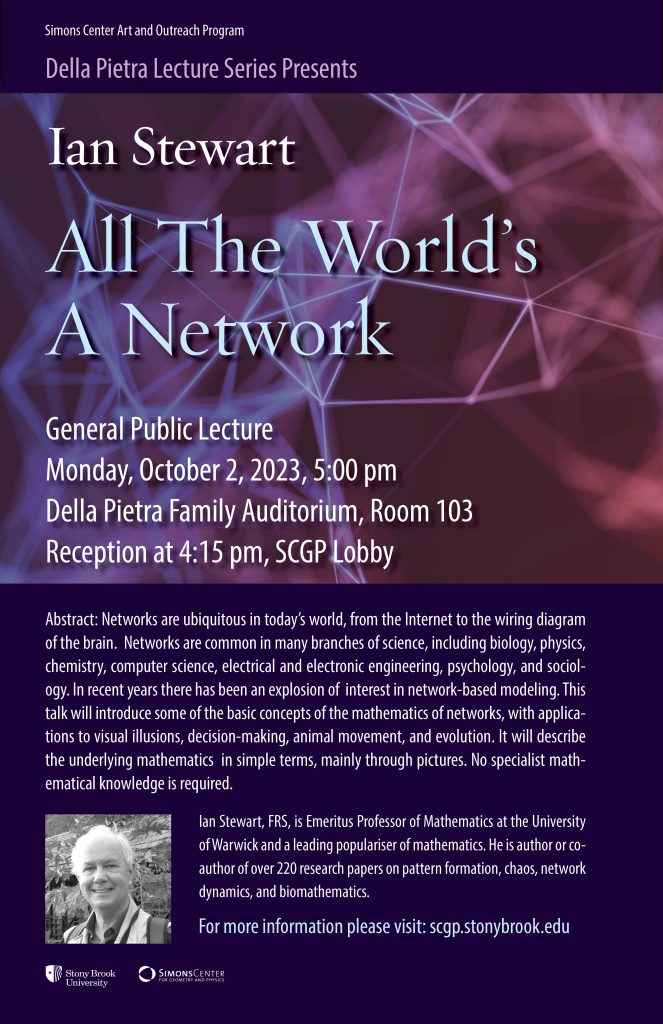The Della Pietra Lecture Series is pleased to present a series of lectures by Mathematician Ian Stewart, University of Warwick
General Public Lecture
Date and Time: Monday, October 2 at 5:00pm
Location: Della Pietra Family Auditorium – 103
Reception at 4:15pm, Simons Center Lobby
TITLE: All the World’s a Network
Abstract: Networks are ubiquitous in today’s world, from the Internet to the wiring diagram of the brain. Networks are common in many branches of science, including biology, physics, chemistry, computer science, electrical and electronic engineering, psychology, and sociology. In recent years there has been an explosion of interest in network-based modeling.
The talk will introduce some of the basic concepts of the mathematics of networks, with applications to visual illusions, decision-making, animal movement, and evolution. It will describe the underlying mathematics in simple terms, mainly through pictures. No specialist mathematical knowledge is required.
Special Talk for High School Students
Date and Time: Wednesday, October 4 at 11:00am
Location: Della Pietra Family Auditorium – 103
TITLE: Tigers’ Stripes and Leopard’s Spots
Abstract: A leopard cannot change its spots” — but how did it get the spots in the first place? The animal kingdom is full of creatures with beautiful markings, from the stripes of tigers and zebras to the apparently random triangles on some seashells. The mathematician Alan Turing is best known for his work on codebreaking during World War II and for early research on computing and artificial intelligence, but he was also interested in biology. In 1952 he proposed a mathematical explanation of how the patterns of animal markings form, based on chemicals called ‘morphogens’ that react and diffuse during key stages of the animal’s development.
The talk will explain the underlying mathematics in simple terms, mainly through pictures. It will be illustrated by numerous examples in the animal kingdom, and mention recent research that confirms some aspects of Turing’s theory.
Technical Talk for Faculty and Advanced Graduate Students
Date and Time: Thursday, October 5 at 2:00pm
Location: Della Pietra Family Auditorium – 103
TITLE: Hidden symmetries in lattice networks
ABSTRACT: Networks of coupled dynamical systems are a current topic of research in many areas of science. The network topology influences the generic dynamic phenomena, often in curious ways. A fundamental example is synchrony, when two or more nodes have the same time series. Patterns of synchrony in networks of coupled dynamical systems can be represented as colorings, in which nodes with the same color are synchronous. Balanced colorings, where nodes of the same color have color-isomorphic input sets, determine robust synchrony patterns, and define a ‘quotient network’ whose dynamics gives that of the synchronous clusters. Subgroups of the symmetry group of the network lead to balanced colorings, but the converse is false.
We consider doubly periodic balanced colorings of the square and hexagonal lattices with nearest-neighbor coupling, and classify the `exotic’ cases where the quotient network has extra automorphisms not induced from automorphisms of the lattice. These comprise some simple infinite families and a few isolated exceptions. The results have unexpected implications for bifurcations to doubly periodic patterns in lattice models.

Ian Stewart FRS is Emeritus Professor of Mathematics at the University of Warwick and a leading populariser of mathematics. He is author or coauthor of over 220 research papers on pattern formation, chaos, network dynamics, and biomathematics. He has been a Fellow of the Royal Society since 2001, and recently served on Council, its governing body, for three years. He has five honorary doctorates and is an honorary wizard of Unseen University on Terry Pratchett’s fictional Discworld.
He has published more than 130 books including Why Beauty is Truth, Professor Stewart’s Cabinet of Mathematical Curiosities, Significant Figures, What’s the Use? and the four-volume series The Science of Discworld with Terry Pratchett and Jack Cohen. He has also written several science fiction novels: Wheelers, Heaven and Oracle with Jack Cohen, The Living Labyrinth and Rock Star with Tim Poston, and the recent Loophole.
He wrote the Mathematical Recreations column for Scientific American from 1990 to 2001. His 100 television appearances include the 1997 Royal Institution Christmas Lectures for the BBC. In one lecture he brought a live tiger into the lecture room, and in another he vanished in a puff of smoke after demonstrating time travel using a wormhole. He has made over 450 radio broadcasts, most of them about mathematics for the general public, and has delivered hundreds of public lectures on mathematics, including the Queen’s Lecture in Berlin. He was Gresham Professor of Geometry at Gresham College, London from 1994 to 1998, delivering six public lectures each year.
His awards include the Royal Society’s Faraday Medal, the Gold Medal of the Institute of Mathematics and Its Applications, the Zeeman Medal (IMA and London Mathematical Society), the Lewis Thomas Prize (Rockefeller University), the Euler Book Prize (Mathematical Association of America), and the Bloody Stupid Johnson Award (Discworld Convention).




